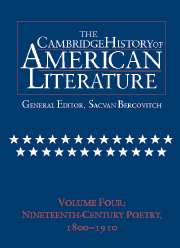Preface: reverence and ambition
from AMERICAN VERSE TRADITIONS, 1800–1855
Published online by Cambridge University Press: 28 March 2008
Summary
In an 1854 lecture entitled “Poetry and English Poetry,” Ralph Waldo Emerson introduced a familiar subject. “The question is often asked, Why no poet appears in America? Other nations in their early, expanding periods, in their war for existence, have shot forth the flowers of verse, and created mythology which continued to charm the imagination of after-men. But we have all manner of ability, except this: we are brave, victorious; we legislate, trade, plant, build, sail, and combine as well as any others, but we have no imagination, no constructive mind, no affirmative books.” Seventeen years earlier, in “The American Scholar,” his criticism had sounded more hopeful. “Perhaps the time is already come … when the sluggard intellect of this continent will look from under its iron lids and fill the postponed expectation of the world with something better than the exertions of mechanical skill.” But the iron lids of the continent had stayed closed, despite the best efforts of Bryant, Longfellow, Whittier, Poe, and Emerson himself (whose Poems had appeared in 1846) to pry them open.
The complaint was freely sounded even in books meant to appeal to national pride. When the New York editor Rufus Griswold (1815–57) published The Poets and Poetry of America in 1842, he cautioned that the United States could be said to have only the beginnings of a national literature. He had chosen the best poems he could find from the five hundred volumes of “rhythmical compositions” that had been published in America since the earliest days of European settlement. But he warned his readers not to expect too much.
- Type
- Chapter
- Information
- The Cambridge History of American Literature , pp. 9 - 16Publisher: Cambridge University PressPrint publication year: 2004

